The third Stalinist blow. Battle of the Crimea
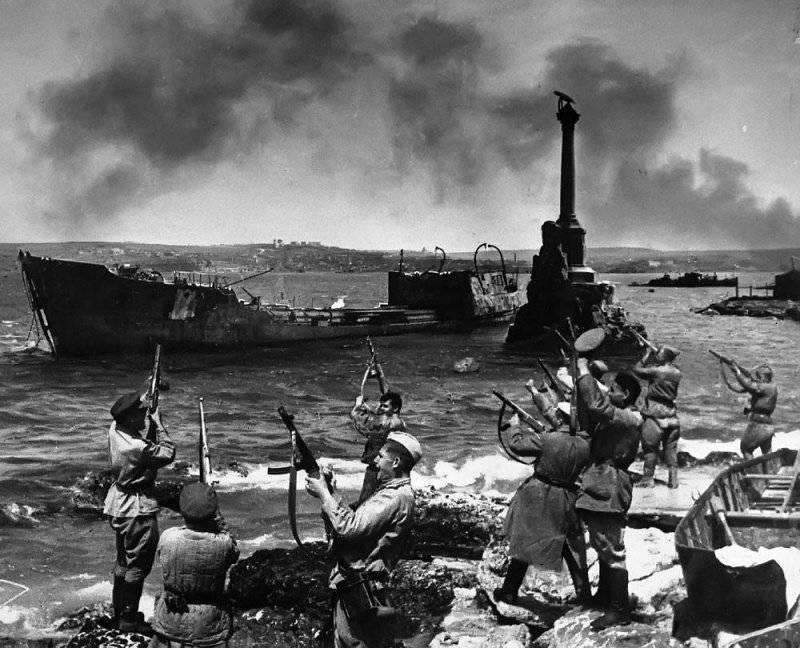
Soviet soldiers salute in honor of the liberation of Sevastopol
The general situation before the operation. Prior Operations
1943 year. The German military-political leadership clung to Crimea to the last opportunity. The Crimean peninsula was of great strategic military and political importance. Adolf Hitler demanded to keep Crimea at all costs. Berlin needed the Crimean peninsula not only for operational reasons (base for air and sea fleet, an advanced outpost of the ground forces allowing the stabilization of the southern flank of the entire front), but from the political. The surrender of Crimea could affect the position of Romania, Bulgaria and Turkey, the general situation on the Balkan Peninsula. The loss of Crimea strengthened the capabilities of the Soviet Air Force and the Black Sea Fleet.
August 13 - September 22 1943. The troops of the South-Western Front, under the command of General F. I. Tolbukhin, during the Donbass offensive operation reached the line of the Dnieper and Molochnaya rivers. Conditions emerged for the liberation of Northern Tavria and the Crimean Peninsula. September 9 - October 9 1943 was conducted Novorossiysk-Taman operation (Liberation of Novorossiysk and the Taman Peninsula). In the course of this operation, Soviet troops liberated Novorossiysk and the Taman Peninsula and reached the coast of the Kerch Strait. The successful completion of the operation created favorable opportunities for strikes against the Crimean group of Wehrmacht from the sea and through the Kerch Strait.
The position of German troops on the southern wing of the Soviet-German front continued to deteriorate further. September 26 - November 5, 1943 The Southern Front (from October 20, 1943 - the 4th Ukrainian) conducted the Melitopol offensive operation. October 24-25, 1943 the 19th tank Corps of General I.D. Vasiliev, Guards Kuban Cossack Cavalry Corps of General N.Ya. Kirichenko and rifle units broke through the German defense. The Red Army was rapidly advancing to Perekop, Sivash and the lower reaches of the Dnieper. As a result of the Melitopol operation, the Red Army defeated 8 enemy divisions and inflicted heavy damage on 12 divisions. Soviet troops advanced 50-230 km, liberating almost all of Northern Tavria and reaching the lower reaches of the Dnieper. German troops in the Crimea were cut off from the rest of the troops. By the end of the day on October 31, the advanced units of the 19th Panzer Corps and the Corps of Corps approached the Turkish Wall and broke through it on the move. On November 1, Soviet soldiers fought in the region of Armyansk. The attack of Soviet tankmen and cavalrymen on the Turkish Wall was so sudden that the Nazis did not have time to organize a powerful defense.
The problem of the advanced units was that they did not have enough artillery, ammunition, besides, the rifle units fell behind. The German command, realizing that the Turkish shaft was broken, organized a powerful counterattack. All day there was a stubborn battle. On the night of November 2, the Nazis again occupied the Turkish Wall with a blow from the flanks. The advanced Soviet units were forced to fight surrounded. German attacks followed one after another. Komkor Vasiliev was wounded, but remained in the ranks and continued to lead the troops. On November 3, the units had 6-7 shells per gun and 20-25 rounds per rifle. The situation was critical. The front headquarters ordered to leave the encirclement, but if possible, to hold the bridgehead. The commander of the 19th tank corps, Ivan Vasiliev (by the Decree of the Presidium of the Supreme Soviet of the USSR of November 3, 1943, Lieutenant General of the Tank Forces Vasiliev was awarded the title of Hero of the Soviet Union) decided to hold the bridgehead and strike from it (from the south) again break through the German positions on the rampart. At night, two small assault detachments (each with 100 fighters) made up of tankers, dismounted cavalrymen, sappers, signalmen and drivers broke through the German defenses. So, the bridgehead south of the Turkish Wall, 3,5 km wide and up to 4 km deep, was able to hold.
At the same time, parts of the 10 Infantry Corps of Major General KP Neverova forced the Sivash and captured another important bridgehead. The German command, realizing the danger of this breakthrough, threw reinforcements with tanks and artillery into battle. However, the Soviet troops received reinforcements. The bridgehead was retained and expanded to 18 km along the front and 14 km in depth. Thus, the operation ended with the capture of bridgeheads on Perekop and south of Sivash, which played a crucial role during the Crimean operation.
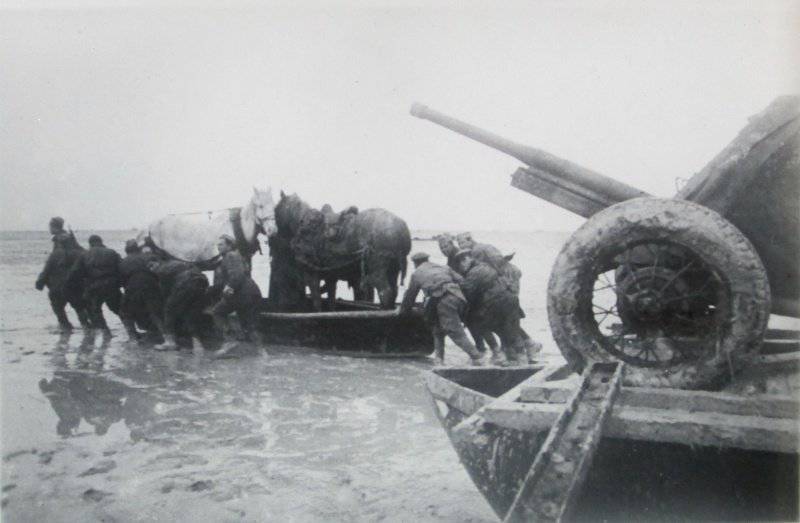
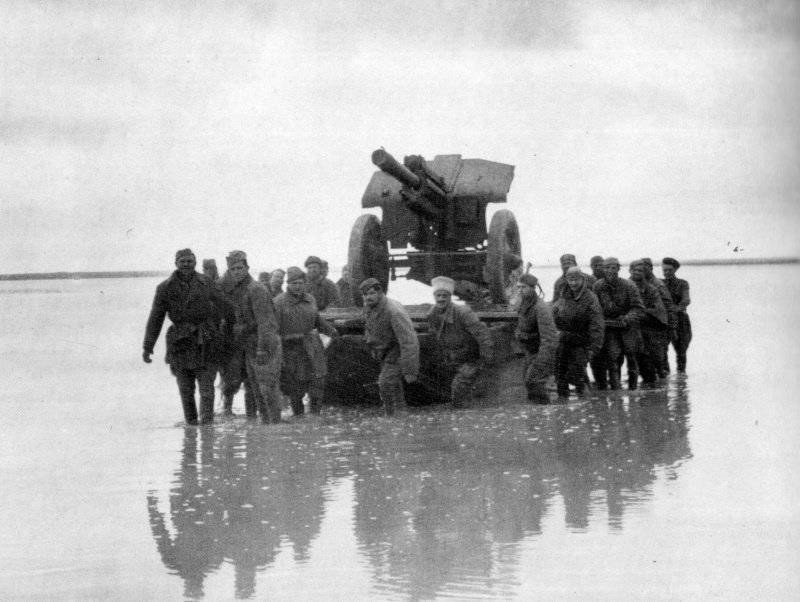
Soviet troops are crossing the Sivash
The commander of the 17 Army, General Erwin Gustav Jeneke, fearing the "new Stalingrad", made a plan for the evacuation of the German troops from the peninsula through Perekop to Ukraine ("Operation Michael"). The evacuation was planned for October 29 1943 of the year. However, Hitler at the last moment banned the operation. Hitler proceeded from the strategic and military-political significance of the peninsula. He was supported by the commander-in-chief of the naval forces, Grand Admiral K. Dönitz. The German Navy Crimea was necessary to control a large part of the Black Sea, the loss of the peninsula sharply worsened the capabilities of the German fleet. The admiral promised that in a critical situation the fleet would evacuate 200-thousand. 17 Army for 40 days (in bad weather - for 80). However, the naval command was mistaken in its forecasts, assessment of the capabilities of the navy and the Soviet troops. When the need arose, the 17 Army could not be quickly evacuated, which was the reason for its destruction.
October 31 - November 11 1943. Soviet troops conducted the Kerch-Eltigen landing operation. The Soviet command planned to liberate the Kerch Peninsula. The peninsula could not be liberated, but an important bridgehead was captured and significant enemy forces were engaged in this area. The German command was forced to deploy troops from the northern (Perekop) direction, where the Nazis planned to launch a strong counter-attack against the advancing troops of the 4 of the Ukrainian Front. The German 17 Army was even more bogged down in the Crimea, now under threat from two directions. The Romanian leadership, having lost confidence in the Germans, began to evacuate its troops from the Crimea.
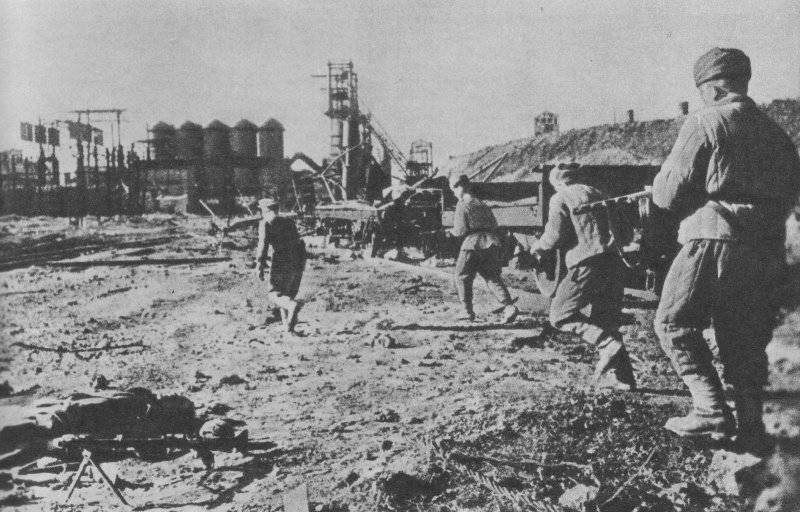
Soldiers of the Separate Maritime Army attack an enemy stronghold on the territory of a metallurgical plant in Kerch
1944 year. German forces and defense
17-I army Jenke (Eneke) was still a powerful and fully combat-ready group. It numbered up to 200 thousand soldiers, 215 tanks and assault guns and about 360 guns and mortars, 148 aircraft. The headquarters of the 17 Army was in Simferopol.
The army received the order of Adolf Hitler to hold on to the peninsula. In the future, the 17 Army, together with the 6 Army, located in the Nikopol area, had to launch a counter-attack on the Red Army and rebuild ground communications with the rest of the German forces. The 17 Army was to play an important role in disrupting the Soviet offensive on the southern wing of the Eastern Front. Back in November 1943, the plans were developed by Litzman and Ruderboot. They envisaged the breakthrough of the most part of the 17 Army from the Crimea through Perekop to the connection with the 6 Army holding the Nikopol bridgehead, and the evacuation of a smaller part of the army by the naval forces.
However, the actions of the Soviet troops thwarted these plans. Parts of the 10 Infantry Corps, which held the bridgehead south of Sivash, improved their tactical position and expanded the bridgehead during several local operations. Troops of the Separate Maritime Army in the Kerch area also carried out a number of local operations, improving their position and expanding the bridgehead. The 17 Army was in an even more difficult position. As noted by General E. Yeneke 19, January 1944 G.: "... the defense of the Crimea hangs on a" silk thread "...".
The position of the 17 army and the actions of the Crimean partisans aggravated. 20 December 1943, the operational and reconnaissance units of the 5 Army Corps recognized the futility of fighting guerrilla groups, since: "complete destruction of large gangs in the mountains is possible only with the involvement of very large forces." The command of the 17 Army also recognized the hopelessness of the fight against the partisans. Partisan detachments were supported by an “air bridge” from the USSR. The Germans tried to terror, including exterminating the population of foothill villages, among whom the partisans were hiding, to suppress resistance. However, punitive measures did not produce the expected results. In addition, to fight the partisans attracted the Crimean Tatars, who collaborated massively with the occupiers.
By April, 1944, in the Crimea, three partisan units were active in the Crimea, with a total of up to 4 thousand soldiers. The most powerful was the Southern Union of the partisans commanded by I. A. Macedon. The southern detachment was located in the reserve of the Southern Coast of Crimea, in the area of Alushta-Bakhchisarai-Yalta. The northern unit, under the command of P.R. Yampolsky, was stationed in the Zuisk forests. The Eastern Union under the leadership of V. S. Kuznetsov was based in the Starokrym forests. In fact, the Soviet partisans controlled the entire mountain-forest part of the peninsula. All the time of occupation, they strengthened their positions. Even some invaders came to them. So, on the side of the partisans, a group of deserting Slovaks fought.
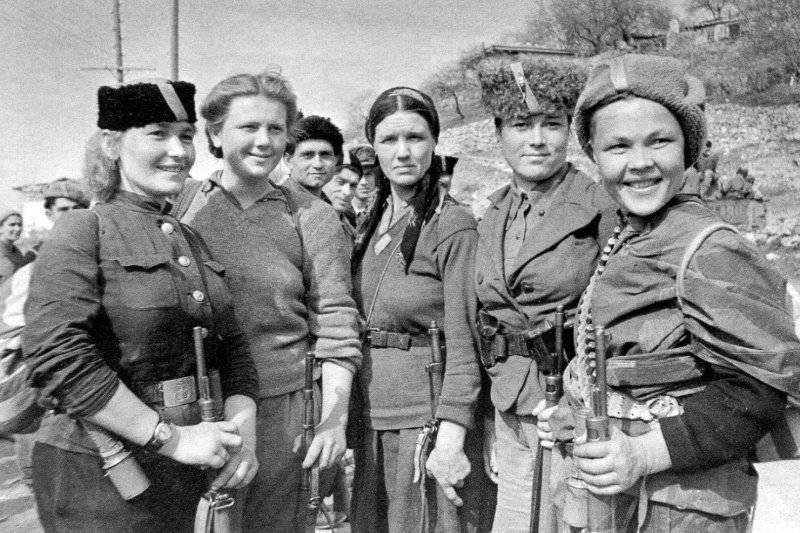
Crimean partisans
January 22-28 The Separate Maritime Army conducted another local operation. The offensive did not lead to success, but showed the precariousness of the position of the 17 Army. The German command had to transfer reserves from the north, which disrupted the possibility of a counterattack from Perekop. From 30 January to 29 February 1944, the troops of the 3 and 4 of the Ukrainian fronts conducted the Nikopol-Krivoy Rog operation (The second Stalinist blow. Part of 3. The defeat of the Nikopol-Krivoy Rog adversary group). The Nikopol bridgehead was liquidated, which finally deprived the Germans of the hope of restoring a land connection with the 17 army encircled in the Crimea. 4-th Ukrainian front was able to send all their forces to the liberation of the Crimean peninsula.
True, in January-February, 73 th infantry division from 44-th separate army corps was transferred by air to the Crimea from the south of Ukraine, and in March - 111-th infantry division from 6-th army of Army Group A. Higher German command still wanted to keep the Crimea. However, the command of the 17 Army understood that reinforcements are not able to change the situation, they only prolong the agony. Yeneke and his headquarters have repeatedly reported to the High Command about the need for the speedy evacuation of the army.
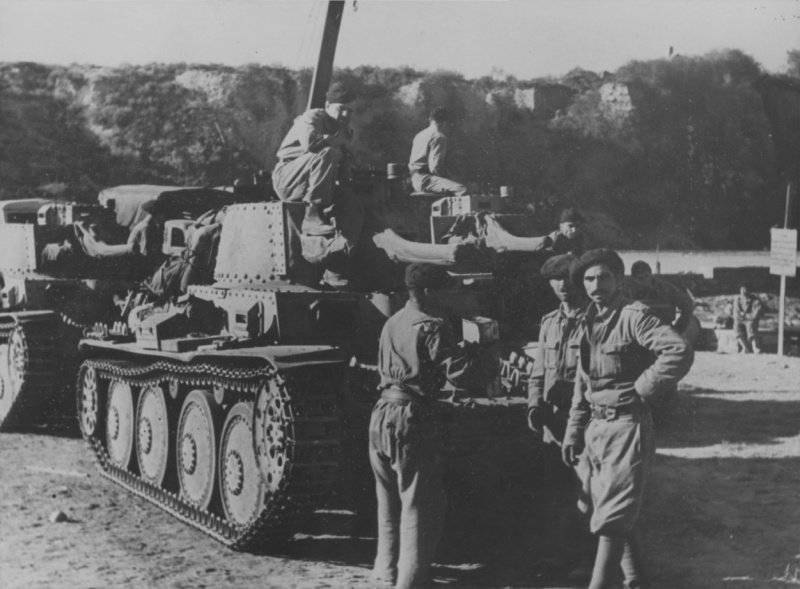
Tanks Pz.Kpfw.38 (t) 2 of the Romanian Tank Regiment in the Crimea
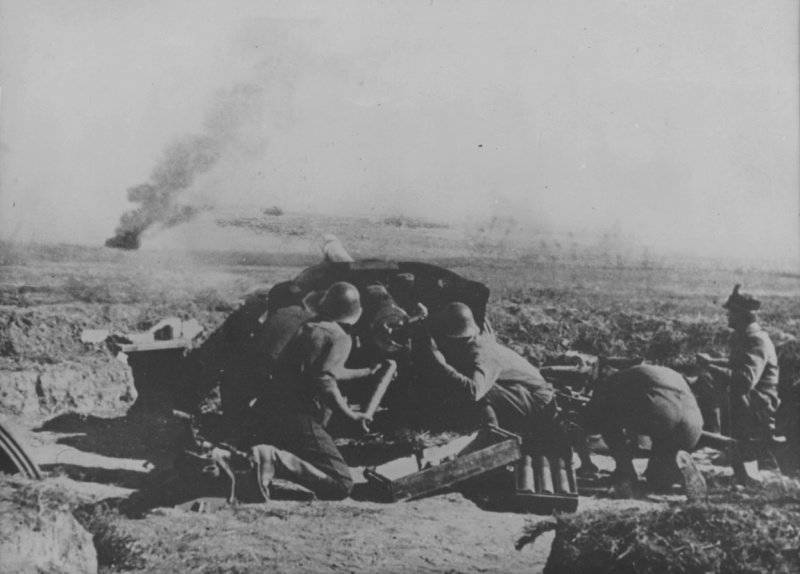
Romanian gunners firing 75-mm anti-tank gun during the battle in Crimea
By April, the 17 Army had 12 divisions: the German 5 and the Romanian 7, the 2 assault brigade brigade. In the area of Perekop and against the bridgehead on the Sivash defense held 49-th mountain infantry corps (50-I, 111-I, 336-th Infantry Division, 279-brigade assault guns) and the Romanian Cavalry Corps (9-th Cavalry, 10 -I and 19-I infantry divisions). Total Northern group consisted of about 80 thous. Soldiers. The headquarters of the group was located in Dzhankoy.
The German defense in the area of Perekop consisted of three lanes up to 14 km in length and to a depth of 35 km. They were occupied by the 50 Infantry Division, supported by several separate battalions and units (only about 20 thousand bayonets, up to 50 tanks and assault guns and 325 guns and mortars). The main defensive zone was the depth to 4-6 km, had three defensive positions with full profile trenches and long-term firing points. The main defense node was Armyansk. From the north, the city covered a deep anti-tank ditch, minefields and anti-tank guns. The city was prepared for all-round defense, the streets were barred by barricades, many of the buildings were turned into strong points. The communication lines connected Armyansk with the nearest populated areas.
The second line of defense took place in the southern part of the Perekop isthmus between the Karkinitsky Bay and the Old and Red lakes. The depth of the second defense zone was 6-8 km. Here the Germans built two defensive positions, covered by an anti-tank ditch, minefields and other barriers. The defense was based on the Ishun positions, which blocked access to the steppe areas of the peninsula. The third defense zone, the construction of which was not completed by the beginning of the offensive of the Red Army, passed along the Chartylyk river. In the intervals between the defense lines there were separate resistance centers and strong points, minefields. On the coast of the Karkinitsky Bay prepared antiamphibious defense. The command of the 17 Army was awaiting the main attack of the Red Army in the Perekop region.
On the southern bank of the Sivash, the Germans built 2-3 defensive lines to a depth of 15-17 km. They were occupied by the 336-I German and 10-I Romanian infantry divisions. Defensive positions passed along the shores of four lakes and had the length of the entire 10 km over land. Due to this, a high density of defense was achieved, saturated with manpower and firing points. In addition, the defense was strengthened by numerous engineering barriers, minefields and bunkers, bunkers. The 111-I German Infantry Division, the 279-I brigade of assault guns and part of the 9-th Romanian Cavalry Division were in reserve at Dzhankoy.
The Kerch sector defended the 5 Army Corps: 73, 98 I infantry divisions, 191 I assault gun brigade, Romanian 6 I cavalry division and 3 I mountain rifle division. Total group consisted of about 60 thousand. Soldiers. The coastal defense in the area from Feodosiya to Sevastopol was assigned to the Romanian 1 mountain shooting corps (1-I and 2-I mountain divisions). The same corps was engaged in the fight against partisans. The coast from Sevastopol to Perekop was controlled by two cavalry regiments from the Romanian 9 Cavalry Division. In total, about 60 thousand soldiers were assigned to the antiamphibious defense and the fight against the partisans. The headquarters of the 17 Army and the Romanian 1 Mountain Rifle Corps were located in Simferopol. In addition, the 17 Army included the 9 Air Force Anti-Aircraft Division, an artillery regiment, three coast defense artillery regiments, the Crimea mountain rifle regiment, a separate Bergman regiment, and other units (security, engineer battalions, etc. .).
On the Kerch Peninsula there were four defense lines. Their total depth reached 70 kilometers. The main line of defense was based on Kerch and the heights surrounding the city. The second line of defense ran along the Turkish Wall - from Ajibay to Uzunlar Lake. The third lane was at the settlements of Seven Wells, Kenegez, Adyk, Obekchi and Karasan. The fourth lane covered the Ak-Monai Isthmus (“Perpach-Position”). In addition, the Germans equipped the rear defense lines on the Evpatoria-Saki-Sarabuz-Karasubazar-Sudak-Theodosia, Alushta-Yalta line. They covered Simferopol. A powerful defensive node was Sevastopol.
Operation plan and Soviet forces
The Headquarters of the Supreme High Command (VGK) considered the Crimean Peninsula as a strategically important area. The liberation of Crimea restored the capabilities of the Black Sea Fleet. Sevastopol was the main base of the Soviet fleet. In addition, the peninsula was an important base of the German fleet and aviation, covered the southern strategic flank of the enemy. Crimea was important in determining the future of the Balkan Peninsula and influenced Turkish politics.
The operation to liberate the Crimea began to prepare in February 1944 year. February 6 Chief of General Staff A.M. Vasilevsky and the Military Council of the 4 of the Ukrainian Front presented to the Stavka a plan for the Crimean operation. 22 February 1944, Joseph Stalin approved the decision on the direction of the main attack from Sivash. To do this, through the Sivash organized ferry, through which the bridgehead began to transfer manpower and equipment. The work took place in difficult conditions. The sea, German air raids and artillery strikes more than once destroyed the crossing.
The start date of the operation was transferred several times. From the beginning, this was due to the expectation of the liberation from the Nazis of the Dnieper coast to Kherson, then due to weather conditions (because of them the start of the operation was postponed for the period between March 15 and March 20). On March 16, the start of the operation was postponed, awaiting the release of Nikolayev and the Red Army’s departure to Odessa. March 26 began Odessa offensive operation (The third Stalinist blow. The liberation of Odessa). However, after the release of Nikolaev - 28 March, they could not begin the operation. Bad weather conditions prevented.
The general plan of the Crimean operation was that the troops of the 4 of the Ukrainian Front, commanded by Army General Fedor Ivanovich Tolbukhin from the north, from Perekop and Sivash, and the Separate Maritime Army from Army General Andrei Ivanovich Eremenko from the east, from the Kerch Peninsula, delivered a simultaneous strike general direction to Simferopol and Sevastopol. They were supposed to break through the German defenses, dismember and destroy the German 17 Army, preventing its evacuation from the Crimean Peninsula. The offensive was supported by the Black Sea Fleet under the command of Admiral Philip Sergeevich Oktyabrsky and the Azov Flotilla under the command of Rear Admiral Sergey Georgievich Gorshkov. The naval forces had a battleship, 4 cruisers, 6 destroyers, 2 patrol, 8 base minesweepers, 161 torpedoes, patrol and armored boats, 29 submarines and other ships and ships. From the air, the 4-UV offensive was supported by the 8-I Air Army under the command of Colonel-General Aviation Timofey Timofeevich Khryukin and the Black Sea Fleet aviation. 4-I air army under the command of Colonel-General Aviation Konstantin Andreevich Vershinin supported the offensive Separate Maritime Army. In addition, partisans were to strike the Germans from the rear. Representatives of the Supreme Command Headquarters Marshals of the Soviet Union K. Ye. Voroshilov and A. M. Vasilevsky were responsible for coordinating the troops. In total, the operation involved about 470 thousand people, about 6 thousand guns and mortars, 559 tanks and self-propelled artillery installations, 1250 aircraft.

Chief of Staff of the 4 of the Ukrainian Front Lieutenant-General Sergey Semenovich Biryuzov, member of the State Defense Committee Marshal of the Soviet Union Kliment Yefremovich Voroshilov, Chief of the General Staff Marshal of the Soviet Union Alexander Mikhailovich Vasilevsky at the command post of the 4 of the Ukrainian Front
The main blow delivered 4-th UV. It consisted of: 51-I Army, 2-I Guards Army and 19-I tank corps. The 51-I army under the command of the Hero of the Soviet Union, Lieutenant-General Yakov Grigorievich Kreyzer and the reinforced 19-Tank Corps under the command of the Hero of the Soviet Union, Lieutenant-General of the tank troops Ivan Dmitrievich Vasilyev, delivered the main blow from the Sivash bridgehead. Ivan Vasilyev will be wounded during the reconnaissance, so the corps will be led by his deputy, I. A. Kissuev. They received the task of advancing in the direction of Dzhankoy - Simferopol - Sevastopol. In the event of a breakthrough of the German defense and seizure of Dzhankoy, the main grouping of the 4-th UV went to the rear of the German positions at Perekop. She could also develop an offensive against Simferopol and into the rear of the Kerch enemy group. 2-I Guards Army under the command of Lieutenant General Georgy Fedorovich Zakharov struck an auxiliary blow on the Perekop isthmus and was supposed to attack in the direction of Evpatoria-Sevastopol. Zakharov's army also had to clear the Nazi coast of Crimea from the Nazis. A separate Primorsk army received the task of breaking through the German defenses at Kerch and advancing in the direction of Vladislavivka and Theodosia. In the future, part of the forces of the Primorye Army was to advance in the direction of Simferopol - Sevastopol, the other part - along the coast, from Theodosia to Sudak, Alushta, Yalta and Sevastopol.
The Black Sea Fleet received the task of disrupting the enemy’s maritime communications. Submarines and torpedo boats were to attack enemy ships on the near and far approaches to Sevastopol. Aviation (more than 400 aircraft) was supposed to operate throughout the German maritime communications - from Sevastopol to Romania. Large surface ships did not participate in the operation. Bid ordered them to protect for future maritime operations. Coordinated the actions of the Black Sea Fleet by the representative of the Stavka, Commander-in-Chief of the USSR Naval Forces, People's Commissar of the Navy, Admiral N.G. Kuznetsov. The Azov flotilla transported troops and cargo through the Kerch Strait and supported the offensive of the Separate Maritime Army from the sea.
Long-range aviation under the command of Air Force Marshal A.Ye. Golovanov (more than 500 aircraft) was supposed to paralyze the work of railway junctions and ports at night massive strikes, strike at important enemy targets, sink German ships and ships. Long-range aviation was to strike at the most important Romanian ports of Galati and Constanta.
Crimean partisans were given the task of disrupting the movement of Germans on the roads, interrupting wire communications, organizing attacks on enemy headquarters and command posts, preventing the Nazis from destroying cities and towns during a retreat, and preventing destruction and hijacking of the population. They also had to destroy the port of Yalta.
To be continued ...
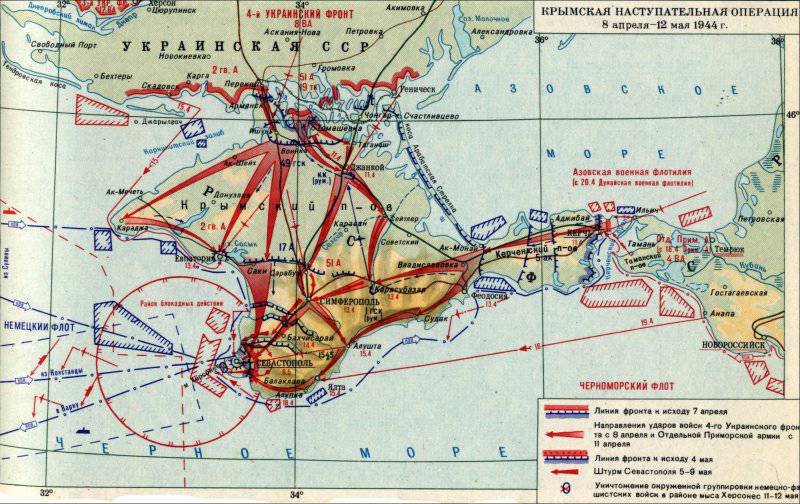
Information